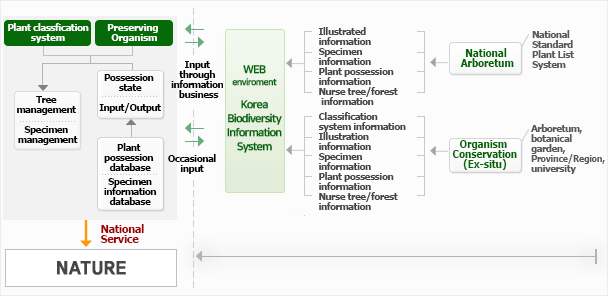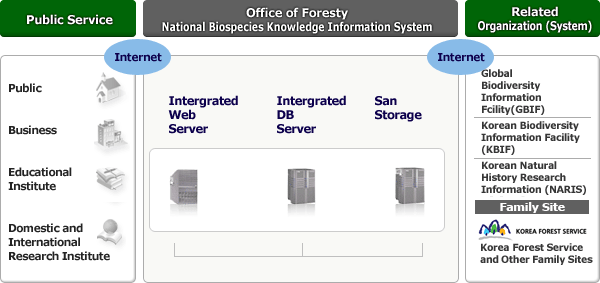Summary of Korea Biodiversity Information System Construction
With the possibility of securing exclusive sovereignty of bioresources following
the conclusion of the UN Conference on Environment and Development’s Convention on Biological Diversity (CBD)
of (adopted in 1994), every country in the world has made positive efforts to protect its own bioresources,
maintain biodiversity and actively strive for balance.
With this trend there is a need for an accurate understanding of the present state of
the species possessed and a connection between bioresources and industrial production infrastructure through
a new recognition of them as resources with an economical value in addition to their as simple value as species.
Accordingly, the Korea Forest Service and Korea National Arboretum have made continuous efforts
for the computerization of national bioresources, including construction of a database and a related applied system
regarding illustrated book information on plants, insects, fungi, and wildlife resources, specimen information
and possessed information, starting with construction of a database project for plant species information in 1998,
for the stable conservation and systematic management of national bioresources.
Through these efforts, the Korea Biodiversity Information System provides information focusing
on the state of national bioconservation and is divided into a nationwide service that provides bioinformation to
the public to satisfy social needs, and an intranet data collection system for the establishment of policies and
research data utilization.
In addition, it counteracts the international trend associated with biodiversity information,
including the construction and connecting service of a biogenetic information network system by commonly applying
interrelated departmental and international data through the Data Portal (www.data.go.kr)
and Global Biodiversity Information Portal (www.gbif.org).
The Korea Biodiversity Information System is progressing step by step with the active
cooperation of university herbariums, arboretums, and botanical gardens, which provide a lot of data.
In order to join in and develop the conservation of national bioresources and complete
the construction of the system together, please give us your precious opinions on the construction
and application of the system, and we will do our best for the successful construction of the Korea Biodiversity
Information System.
Expected effects of Korea Biodiversity Information System
1.Securing national bio-sovereignty and enhancing the nation’s image and status as a knowledge
powerhouse in the world
2.Provision of information to support strategies
and establish policies to preserve bioresources
3.Construction of computerization and various research bases for the accumulation
and continuous improvement of bioresource-related knowledge
4.Construction of a data collection system and network for long-term monitoring of bioresources
5.Provision of actual information possessed to support the industrialization of bioresources
6.Satisfaction of social demand for various biodiversity-related information
and global sharing of biodiversity information
Aims of Korea Biodiversity Information System Construction
Main contents of Korea Biodiversity Information System
- 1. Plant resource information: Illustrated plant book, plant specimens, plants possessed by arboretums, protected plants, seed information
- 2. Insect resource information: Illustrated insect book, insect specimens, protected insects
- 3. Fungus resource information: Fungus information
- 4. Wildlife information: Mammal information, Bird information
Management and application of Korea Biodiversity Information System
- Computerization of specimen and collection data held in various arboretums, botanical gardens, and universities to understand the in-situ conservation state of species
- Computerization of data on species, individual information, plant sites, state of possession, and growth state in each arboretum and botanical garden for the ex-situ conservation state in arboretum and botanical gardens that collect, conserve, and propagate plant species
- Computerization and data management of possession lists, planting sites, state of possessions, and growth state of nurse trees and nurse forests under the management of mayors, governors, or directors of local forest services, and construction of data over years to monitor the state of possession.
- Construction of a database for fungi and wildlife specimens possessed by the Korea National Arboretum and provision to the general public
- Biology Class for Kids – Biology school, Find Living organism friends, Information class, Use guide
S/W composition of Korea Biodiversity Information System


 Korea Biodiversity Information System > Bioinformation Library > Site Introduction
Korea Biodiversity Information System > Bioinformation Library > Site Introduction

